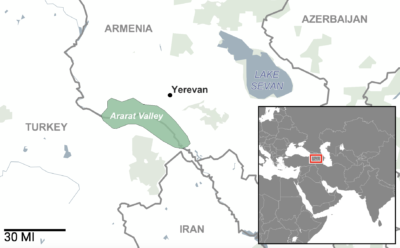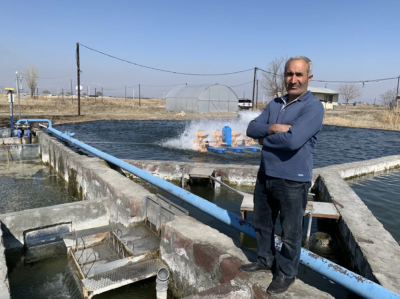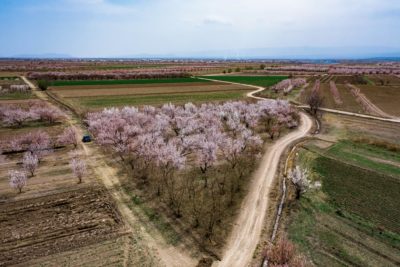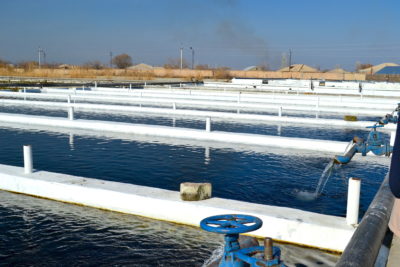On an overcast morning this previous spring, Gegham Muradyan searches for indicators of water trickling by the dry soils of Armenia’s Ararat Valley. In a gap between two stone homes within the village of Dalar, some 15 miles southwest of Yerevan, the nation’s capital, he finds a single pipe protruding from knots of weeds.
A hydrometeorologist at Armenia’s Ministry of Surroundings, Muradyan holds a measuring cup beneath the water flowing from the pipe and notes the time it takes to fill. He does a fast calculation, then data the properly discharge price — an indicator of underground water strain — in a logbook. Over the previous yr, the speed has dropped from 850 milliliters per second to 570 milliliters. “That’s very severe for this one,” he says.
For a number of years, Muradyan and his colleagues have crisscrossed this area to file the depth and velocity of groundwater at wells and boreholes. In 2016, they surveyed greater than 2,800 websites — probably the most complete evaluation carried out because the early Eighties. Their painstaking work has confirmed that the aquifer has shrunk from greater than 32,000 hectares, in 1983, to only over 10,000 hectares. In some elements of the valley, the water desk has dropped as a lot as 49 toes.
Years of overexploiting groundwater within the Ararat Valley have introduced the aquifer to a disaster level.
Muradyan is aware of why. “Go searching,” he says, pointing towards the horizon. “Do you see these?” Barely perceptible within the distance are rows and rows of concrete vats crammed with fish.
Years of overexploiting groundwater within the Ararat Valley have introduced the aquifer to a disaster level. Right this moment, the valley hosts greater than 200 documented fish farms, with doubtlessly dozens extra working with out permits. Collectively they’re liable for greater than half of the area’s annual groundwater consumption, in keeping with information collected by the U.S. Company for Worldwide Growth — greater than irrigation, industrial, and family use mixed.
Rainfall and snowmelt replenish the aquifer, however local weather change has lowered these flows. Now, regardless of authorities efforts to close down unlawful wells and encourage water reuse on fish farms, specialists say extra must be executed to protect this important pure useful resource.
The Ararat Valley, which lies alongside the Turkish border and is house to roughly 260,000 folks, is the nation’s agricultural hub. Its prized apricots and pears, its melons and greens, have lengthy thrived because of the valley’s artesian aquifer, which holds an estimated 2 billion cubic meters of water, equal to about 800,000 Olympic swimming swimming pools.

Yale Surroundings 360
However right this moment, a chook’s-eye view of the area would reveal a stark distinction: a dusty, brown panorama dotted with hanging blocks of blue and inexperienced. These tanks are crammed with native trout, salmon, and sturgeon, most of which can be exported to Russia.
Aquaculture is the world’s fastest-growing meals sector, in keeping with the United Nations. However business fish farming is comparatively new in Armenia, and an unlikely business for a mountainous, landlocked nation. The federal government first granted water extraction permits within the 2000s, permitting dozens of entrepreneurs to faucet into the valley’s aquifer. Hydrologists say these early permits allowed aquaculturists to arrange too many wells that pumped an excessive amount of water, and that the permits had been granted with out an understanding of how a lot extraction the aquifer might deal with.
“It was not good administration and never a long-term imaginative and prescient for the Ararat Valley,” says Alexander Arakelyan, a hydrologist at Armenia’s Institute of Geological Sciences, who works with Muradyan.
These days, aspiring fish farmers pay about $1,000 for a water allow, in keeping with Muradyan. However as soon as they’ve executed that, the clear, chilly water is nearly free — fish farmers can fill a whole tank, about 280,000 liters, for just some {dollars}. It’s not shocking, then, that the valley rapidly grew to become a hotspot for enterprising aquaculturists, who triggered intensive groundwater depletion in just some years.
The Ararat Valley, which receives simply 8 to 10 inches of precipitation yearly, is prone to grow to be even drier.
As fish farming has grown, groundwater withdrawals within the Ararat Valley have far surpassed the aquifer’s price of replenishment. The issue was first found in 2013, when groundwater withdrawals had been greater than 1.5 occasions the sustainable degree. Three years later, nothing had modified. Customers withdrew 1 billion cubic meters greater than the aquifer’s pure recharge quantity for that yr.
“If we maintain utilizing [the aquifer] indiscriminately,” says Muradyan, “the time will come when it can not get well.”
For a time, the issue appeared to be beneath management. In 2016, the Ministry of Surroundings tried to shut unlawful farms and plug among the valley’s unused, free-flowing wells. However now the warming local weather — which reinforces evaporation, triggers extra drought and ramps up water demand — is exacerbating the disaster, says Alexander Arakelyan, a hydrologist on the Institute of Geological Sciences in Armenia.
Groundwater is a very powerful supply of water for at the very least half of the world’s households and helps a few quarter of the world’s irrigation techniques. However because the planet warms, water shortage is anticipated to have an effect on two-thirds of the world’s inhabitants by mid-century, in keeping with the U.N.

Fish farmer Asatur Muradyan at his operation within the Ararat Valley.
MELISSA BURNES / USAID – ARMENIA
The Ararat Valley, which has traditionally acquired simply 8 to 10 inches of precipitation a yr, is prone to grow to be even drier. The United Nations Growth Programme predicts rainfall will lower by about 8 p.c by 2100. “Armenia is warming a lot quicker than anticipated,” says Naira Aslanyan, local weather change coordinator on the UNDP in Yerevan.
This previous winter, the shortage of snowpack dramatically shifted the basin’s timeframe for regeneration. Often, the water desk rises till April as snow from the encompassing mountains melts into the valley’s recharge zones. However in 2022, the regeneration season resulted in February, in keeping with Muradyan. This yr, he says, the water desk began declining even earlier — in January.
The implications of a decade of unmitigated groundwater abstraction and growing local weather pressures are already rising, generally miles away from the heaviest customers. Gevorg Avakian grows strawberries, eggplants, and grapes on a small farm within the village of Aknashen. Up till 2016, water flowed freely from an artesian properly on the sting of his property, between the hen pen and some rows of grape vines.
“It’s not the proper method if we expect that we are able to convey water from different locations to shut the deficit,” says a hydrologist.
In 2016, Muradyan helped set up a deeper properly on Avakian’s property to switch one which had dried up. However even this one is dying. “It’s solely happening and down,” says Avakian. “You possibly can see the fields round me. They’re all yellow. That’s as a result of the water isn’t coming.” Avakian discovered the cash to put in a pump on his dry properly, however it’s costly to function.
In additional than 30 communities dotting the valley, residential wells at the moment are too shallow to succeed in the ever-dropping water desk. Villagers — not all of whom have entry to municipal water provides, which draw on reservoirs — have watched their wells dry up within the house of some quick years. Like Avakian, they’re pressured to both dig deeper or set up expensive pumps.
Farmers who partly depend upon the aquifer for irrigation are more and more reliant on water discharges from Lake Sevan — a big, freshwater lake about 45 miles northeast of the Ararat Valley that’s already affected by algal blooms and low water ranges. This summer time, the Armenian authorities agreed to discharge 240 million cubic meters of water from the imperiled lake to service shortfalls across the nation, regardless that the annual most is ready at 170 million cubic meters.

Farmland within the Ararat Valley.
WIRESTOCK, INC. / ALAMY STOCK PHOTO
“It’s not the proper method if we expect that we are able to convey water from different locations to shut the deficit,” says Arakelyan.
Nonetheless, many native fish farmers received’t settle for that they’re a part of the issue. Samvel Lablajyan, based mostly outdoors of Hayanist village, insists nothing has modified on his plot of land. “The water isn’t happening, and it isn’t going up, both,” he says. “This example will work for 100,000 years.”
In different elements of the Valley, Lablajyan concedes, “there are locations the place the water is reducing naturally.” He blames local weather change. “There’s no rain, the winds are stronger, every little thing on the Earth is altering,” he says.
Groundwater just isn’t evenly distributed beneath the Earth’s floor, so some areas could really feel the pinch of depletion greater than others — at the very least for now. Fish farmers like Lablajyan, says Arakelyan, will inevitably come face-to-face with the issue. “We have to [make] these companies perceive that this atmosphere is for everybody, it’s not a non-public factor,” he says.
After harvesting their fish, most farmers drain their nitrogen-rich water into the close by Aras River.
Consultants say the entire basin’s residents need to face actuality: The years of insatiable extraction have caught up with them. “We don’t need to get to a scenario the place we have now an enormous water scarcity, and we’re not that far off,” says Garabet Kazanjian, an aquatic ecology researcher on the American College of Armenia. “What are we going to do then?”
Highly effective financial pursuits have stymied any reforms of aquaculture. After years of financial hardship, fewer Armenians are selecting to work the land. Many younger folks have moved to town or left the nation altogether. Creating employment alternatives for the remaining rural inhabitants is extra essential than ever.
Fish farms yearly produce greater than 18,000 tons of economic fish, most of which is exported to Russia, in keeping with the Ministry of Financial system. Russian shoppers have a style for Armenian purple and black caviar, in addition to its trout and sturgeon — varieties which can be too costly to be viable on Armenian grocery cabinets. The farms additionally make use of native villagers. Artyom Torosyan’s enterprise, referred to as Svet Fish, recruits 10 folks from Hovtashat, a village of about 3,000. Dozens of different fish farms do the identical.

Fish farms within the Ararat Valley use groundwater to boost trout, sturgeon, and different fish, most of that are exported to Russia.
Janet Carter / USGS
Torosyan’s expansive enterprise is inconceivable to overlook on Hovtashat’s Yerkatughayinner (steel works) Road. His elaborate, brass-trimmed gates stand out on the grime highway, the place a half-mile of dilapidated factories as soon as produced automobile elements and equipment. Torosyan believes he’s a part of revitalizing the nation’s economic system and its international standing, he says, as a result of 90 p.c of his product goes overseas.
Nonetheless, Torosyan calls himself one of many unfortunate fish farmers: neighboring farms have about 5 permitted wells every, he says, whereas he has a allow for just one. And so Torosyan, like different aquaculturists with out sufficient water, carried out water-saving measures out of want.
After harvesting their fish, most farmers drain their nitrogen-rich water into the close by Aras River, which flows to the Turkish border. The method is each wasteful and polluting. On Torosyan’s farm, a system filters the water, reoxygenates it, after which reroutes it to a different tank, able to host a number of hundred extra fish.
The tempo of depletion will decide whether or not the fish farming business can proceed to function.
Torosyan constructed the recirculating system himself, importing supplies from China, Russia, and the European Union, and he believes his efforts may very well be a blueprint for the area’s different fish farms. However whereas recirculating techniques lead to larger fish manufacturing with much less water use, the capital funding — from $16,000 to $130,000, relying on the scale of the farm — may be prohibitive for smaller farms, in keeping with analysis from the Worldwide Centre for Agribusiness Analysis and Training, an agricultural NGO based mostly in Yerevan.
Nor do comparatively water-rich fish farms have any incentive to put money into constructing a sustainable system, says Torosyan. “The fish farms round me have a number of water already,” he says. “They don’t use these sorts of processes.”
Nonetheless, native environmental authorities are encouraging widespread adoption of recirculating techniques. In January, the Ministry of Surroundings gave fish farms one yr to put in them, however specialists on the bottom haven’t seen any progress. “I’m not so positive that will probably be executed by January as a result of it requires some huge cash and energy from companies,” says Arakelyan. And with out authorities subsidies to make the upgrades, smaller companies would possibly shut if the deadline stays. “As typical in Armenia,” Arakelyan provides, “every little thing will occur on the final second.”
Even for an enterprising operator like Torosyan, there may not be a lot water left to recirculate inside a couple of a long time. The tempo of depletion will decide whether or not the fish farming business can proceed to function. “If the water runs out,” Torosyan says, “we’re all going to be in bother.”


